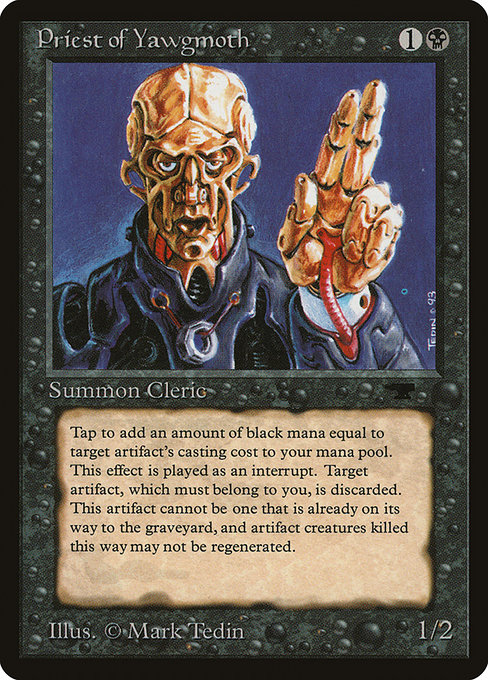
Image courtesy of Scryfall.com
Collector Psychology in MTG Market Bubbles: Lessons from a Phyrexian Cleric
Market bubbles in Magic: The Gathering aren’t just about numbers ticking up or down; they’re about stories, scarcity, and the way collectors anchor value to memory as much as to playability. 🧙♂️ When a card from the antiquities era—like a common Phyrexian cleric—suddenly becomes a focal point for conversation, you’re seeing a microcosm of the broader psychology at work: the thrill of discovery, the fear of missing out, and the comfort of owning something that feels timeless. The Priest of Yawgmoth from Antiquities isn’t the tallest tree in the current forest, but its tale offers a smart lens into how collectors think about risk, reward, and what we really value in a volatile market. 🔥
At first glance, Priest of Yawgmoth is deceptively modest: a 2-mana black (B) creature, a 1/2 with the ability to turn a sacrificed artifact into mana. The line, “{T}, Sacrifice an artifact: Add an amount of {B} equal to the sacrificed artifact’s mana value,” is a quiet reminder that old-school design can hinge on artifact interaction. In a bubble, that interaction becomes a narrative hook: you’re not just buying a card; you’re investing in a concept—sacrifice as a route to power, commodified in a single push of a tap. It’s the kind of evergreen mechanic that helps players imagine longer-game plays, even when the initial price tag isn’t sky-high. ⚔️
Card snapshot and the flavor of early Magic design
- Mana cost: {1}{B}
- Type: Creature — Phyrexian Human Cleric
- Power/Toughness: 1/2
- Oracle text: "{T}, Sacrifice an artifact: Add an amount of {B} equal to the sacrificed artifact's mana value."
- Color identity: Black
- Set: Antiquities (ATQ), 1994
- Rarity: Common
- Artist: Mark Tedin
The card’s lineage—printed in the early, experimental era of Magic—reflects a philosophy that valued clever, budget-friendly interactions. In a bubble, that budget-friendliness contrasts with the modern desire for flashy, iconic rares. Yet the Priest’s very ordinariness becomes its vitality: it’s a reminder that strategy, not just shininess, can anchor value over time. And because it’s a nonfoil common from Antiquities, it tells a story about supply dynamics that still matter to collectors today. 🧩
Market dynamics: how a card teaches risk and reward
When market bubbles swell, collectors often chase “playable myths”—cards that promise outsized impact in certain decks or formats. Priest of Yawgmoth embodies a dual appeal: it’s both a nostalgia piece for longtime players and a tangible example of how artifact-based mana can scale with the right board condition. The risk is obvious: the card’s reprint risk and the broader reallocation of focus to newer, shinier legends. The reward, if you’re patient, can be steadier appreciation tied to casual and commander play, where artifact ecosystems remain relevant. And that’s where the psychology clicks: belief in a card’s utility helps justify its presence in a collection, even when the market feels feverish. 💎
Macro trends push bubble instincts further. Media coverage, social media hype, and the comfort of data dashboards can nudge collectors toward faster decisions—grabbing “value” if a card looks like it could spike due to a popular commander synergy or a new interpretation of artifact ramp. The Priest of Yawgmoth, with its historical flavor and practical, pulp-era ramp, serves as a counterpoint to the modern trend of chasing ultra-rare etchings. It reminds us that sometimes the clearest signal isn’t price velocity but a card’s enduring utility in archetypes that celebrate artifact synergy, tempo, and black mana’s flavorful acceleration. 🧭
From shelves to sleeves: translating theory into practice for collectors
For collectors, the key takeaway is to separate story from strategy and myth from math. A card’s value often travels with the story we tell about it: the lore of Phyrexian priests, the artistry of Mark Tedin, and the badge of Antiquities history all combine to create a narrative that can outlive sudden price surges. If you’re eyeing market bubbles, keep a few guardrails in mind: consider format viability (Commander and Legacy for this card’s lineage), evaluate the artifact ecosystem around your decks, and assess whether the card’s price is supported by long-term play or by ephemeral hype. And yes, keep your collectibles safe—in the real world as well as in the game—because value is as much about condition and access as it is about scarcity. 🧙♂️🎨
While you journey through the bubble cycles, you’ll also discover a kinship among collectors: a shared enthusiasm for the unsung corners of the card pool, where simple designs yield real value with the right setup. The Priest of Yawgmoth invites you to think about how sacrifice creates forward motion—both in your decks and in your collection. It’s a reminder that a well-timed sacrifice can unlock something larger, just as thoughtful buying can unlock lasting joy in your binder. 🔥🎲
And as you map the balance between nostalgia and necessity, consider how everyday goods can echo that balance. A sturdy, protective phone case—like the Clear Silicone Phone Case Slim Durable Open Port Design—can be a small but meaningful companion for any collector on the go, a practical shield for the life you’re building around your hobby. The connection may feel cheeky, but it’s real: care for what you own, and it will carry you through the next market wave. ⚜️
Product spotlight: Protect your gear and keep your prized collection safe as you explore the next bubble—with practical, minimal protection that doesn’t get in the way of access or display. Clear Silicone Phone Case Slim Durable Open Port Design
More from our network
- https://transparent-paper.shop/blog/post/grow-your-audience-with-content-marketing-for-digital-creators/
- https://blog.digital-vault.xyz/blog/post/creature-bond-spell-maximizing-mana-efficiency-in-mtg/
- https://transparent-paper.shop/blog/post/the-future-of-programmatic-advertising-trends-to-watch/
- https://crypto-acolytes.xyz/blog/post/day-trading-in-a-crypto-bear-market-survival-tips/
- https://crypto-acolytes.xyz/blog/post/distant-blue-giant-illuminates-the-hertzsprungrussell-diagram/